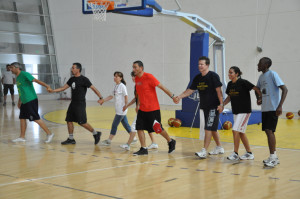Recently I posed the question “To board or not to board?”
It was meant to be rhetorical. To get you to think about what may/may not be working with your board. And/or with the board’s relationship with your E.D. And/or with your board’s engagement with fundraising. Because unless you’ve got smooth sailing in these regards, it’s going to be difficult to “Dive the 5” Fundamentals I’m encouraging you to focus on this year.
Ah, pre-conditions. They’ve always got to be in place. First.
So… let’s continue to take a few steps back this week and talk about your board’s critical role.
Boards can make or break your fundraising efforts.
The good ones are more than worth their weight in gold.
The bad ones are quicksand. They’ll sink you so fast – and keep you up nights with that sinking feeling.
What can you do to raise boards up and unlock the participation of your board members?
Teach them to play board games!
Of course, before you can do this you’ve got to have board members who like to play these games.
- Who’d recruit a bunch of non-card players to a poker game? It would end up being a very short evening. And no one would really enjoy it.
And who have the ability to play these games.
- Who’d recruit amputees to a kick-ball tournament against a team of two-legged players? You’d probably not win.
Yet, sadly, it’s all too common to see nonprofits recruit folks who don’t want to “play,” or who simply can’t play, to their boards. They’ll come right out and tell you:
“I’m here to represent the community and give advice.”
“I don’t do fundraising.”
“We’re not a fundraising board.”
This is like playing a board game with someone who always wants to skip his turn!
Make sure the folks you recruit really want to play.
Be up front with them about what you’re inviting them to do. Let them know they wear two gloves: (1) the glove of the board as a whole, and (2) the glove of the individual board member.
- Wearing the board glove, the responsibility is to make governance decisions – set policy and direction, hire/fire the E.D. and approve strategic plans and budgets (the “talk”).
- Wearing the member glove, the responsibility is to act in a manner to assure the board’s decisions are carried out through adequate financing – this is how the budget gets balanced (the “walk”). If they don’t walk the talk they’re merely creating unfunded mandates (they may as well go work for Congress).
How do you show board members how to walk and talk simultaneously?
Teach board members the art of the one-two punch.
 It takes both hands to get a knock-out. One-handed boards operate at a severe handicap. They can set things up, but they can never get things done.
It takes both hands to get a knock-out. One-handed boards operate at a severe handicap. They can set things up, but they can never get things done.
“We cultivate and cultivate, but seldom get to the ask.”
Does that sound familiar?
Here’s the problem. Boards are often too happy to use their governance glove all day long, but are loath to pick up their financing glove. Alas, you really can’t exercise your fiduciary responsibility as a “governor” unless you’re willing to use your “financing” glove to assure fulfillment of the organization’s mission. Money must come in the doors.
If you can define “money coming in the doors” broadly, you’re sure to find a role for every board member.
Teach board members to spell “fundraising” with 3 “A’s”
I could write a book on all the ways staff go wrong asking board members to raise funds. It boils down to: (1) fear (see here, here and here), and (2) lack of clarity about their role (see here, here and here).
All of this can be overcome if you can reframe the fundraising role for boards, and make it a bit less threatening. Tell them this role is played wearing three different hats. They can wear all of them, or one or two of them. They can’t wear none of them.
 The “three hats” system is called “AAA” fundraising, a paradigm developed by my friend, mentor and colleague Kay Sprinkle Grace. In a nutshell, board members can help fundraise in any or all of these three ways — each of which will connect supporters closer to your cause:
The “three hats” system is called “AAA” fundraising, a paradigm developed by my friend, mentor and colleague Kay Sprinkle Grace. In a nutshell, board members can help fundraise in any or all of these three ways — each of which will connect supporters closer to your cause:
- Ambassadors – Make friends; build relationships; speak from personal passion; identifies prospects
- Advocates – Make the case, get coached to represent the organization to the public; recruit volunteers
- Askers – Make the match; front-line fundraiser
Each board member is offered an array of potential assignments from which to choose. Each is geared to different motivations and skills. Members agree to assignments they’re comfortable with, and staff use this as a management tool to ensure follow-through.
Re-introduce board members to the game of “Follow the Leader.”
 Due to their unique position as role models, this may be the most important game a board member plays. A growing body of research shows human beings are supremely social creatures. We use the brains of others to think for us and as storage space for our knowledge about the world.
Due to their unique position as role models, this may be the most important game a board member plays. A growing body of research shows human beings are supremely social creatures. We use the brains of others to think for us and as storage space for our knowledge about the world.
It was Aristotle himself who first described humans as “social animals,” and indeed his observation from 350 B.C. has been borne out by the field of evolutionary anthropology. According to the authors of I’ll Have What She’s Having: Mapping Social Behavior, we are a ‘we’ species, not a ‘me’ species. People tend not to think for themselves; they follow the lead of others whom they respect and admire.
We are products of a herd mentality. We’ve a tendency to pay tribute to the alpha male (or female) within the group. We look for guidance… power… strength… authority… leadership. And, if you will, the board represents the alpha males in your group/organization/community.
In considering whether and how to get involved with any nonprofit, people will look first to the board for guidance. You ignore this at your peril.
Replace “Tug of War” with “Chain Tag.”
 If you and your board are in a constant tug of war, teach them to play “Chain Tag” instead. It’s a traditional children’s game where, once you get tagged by whoever is “it,” you link hands with them and become part of a chain. The newly formed chain collaborates, chasing everyone else around until there’s only one left in the corner. Get it? Rather than trying to get someone “out,” creating a sense of isolation, everyone joins together to tackle the matter at hand.
If you and your board are in a constant tug of war, teach them to play “Chain Tag” instead. It’s a traditional children’s game where, once you get tagged by whoever is “it,” you link hands with them and become part of a chain. The newly formed chain collaborates, chasing everyone else around until there’s only one left in the corner. Get it? Rather than trying to get someone “out,” creating a sense of isolation, everyone joins together to tackle the matter at hand.
Your board needs to become networked; then use their board and personal networks to influence others to join your cause. Authors like Malcolm Gladwell in The Tipping Point, Duncan Watts in a series of publications on social networks, Nicholas Christakis in Connected: The Surprising Power of Our Social Networks and How They Shape Our Lives, and Stanley Milgram who developed the notion of “Six Degrees of Separation” (though he did not use that phrase himself) teach us that networks matter, and that some folks within networks are more influential than others. These are the folks you want to bring onto your board. And these are the folks you want to be sure will use their influence on your behalf.
It turns out that influencers – just like “it” in a game of tag– have tremendous power and clout. Influencers influencing; this is a critical role board members can play for your organization.
It’s easy to play the blame game.
It’s easy to blame board members. It’s more difficult to take a look in the mirror and realize that you’re not setting your board members up for success through clear direction, training, coaching and cheerleading. If they don’t know the rules going in, how can they even play – let alone be successful?
If you can get your board members playing the right board games, pretty soon you’ll all be jumping on the bed with joy. Have fun!
For more on this topic, check out this free downloadable interview with Natasha Golinsky of Next Level Nonprofits, all about how E.D.s can work with boards to make them passionate, joyful ambassadors, advocates and fundraisers.
Do you have a good way to help your board step up to their role as influencers and leaders?
 For even more, check out Major Gifts Actionable Checklists & Cheat Sheets. You’ll get 5 e-books with answers to frequently asked nitty gritty questions, including one on “Leadership’s Role in Major Gift Development.” Lots of brass tacks stuff.
For even more, check out Major Gifts Actionable Checklists & Cheat Sheets. You’ll get 5 e-books with answers to frequently asked nitty gritty questions, including one on “Leadership’s Role in Major Gift Development.” Lots of brass tacks stuff.
Photos courtesy of podpad, marcolm at Freedigitalphotos.net




